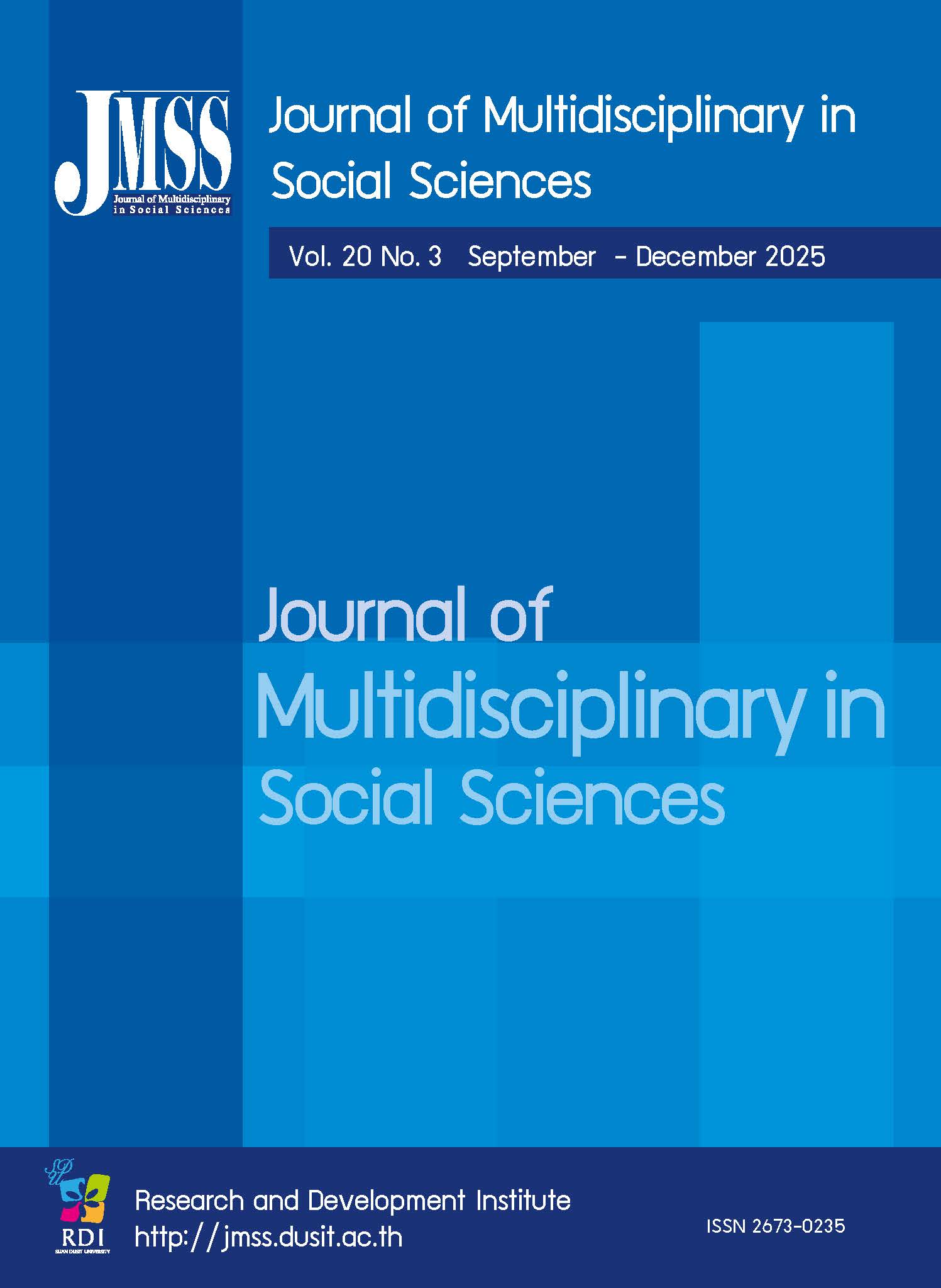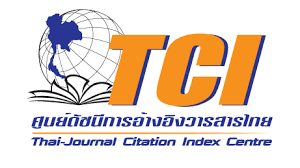Exploring Cohesion in a Thai Multinational Manufacturing Company: A Social Network Analysis Approach
Keywords:
Cohesion, Cohesive measures, Mergers and acquisitions, Social network analysisAbstract
This study explores the concept of "cohesion" within a multinational manufacturing company in Thailand that has recently undergone post-merger integration. Employing a quantitative approach and adopting a social constructivist epistemological stance, this research analyzes cohesion through the lens of social network analysis. Although conventional measures of cohesion (N=315 'ego-seeds'; n=21,416 ego-alter pairs) yield scores above the midpoint of the scale, our examination of network cohesion scores and network graphs at the organizational, group, and individual levels challenges the notion of cohesion in this case. We also investigate the strength of weak ties. Furthermore, the network graphs provide unique insights into participants' perspectives that are not captured by traditional research methods. The findings suggest that cohesion in this context requires not only work-related group connections but also social and inter-group associations and reciprocity at a broader organizational level. These insights advocate for the incorporation of theoretical models based on the social identity approach to enhance post-merger integration processes involving inter-group relations. By examining a post-merger integration case, this study contributes to our understanding of how to enhance cohesion as a desired outcome of successful mergers and acquisitions.
References
Adams, P. (2006). Exploring social constructivism: theories and practicalities. Education 3-13, 34(3), 243-257.
Aron, A., Aron, E. N., & Norman, C. (2004). Self-expansion model of motivation and cognition in close relationships and beyond. In M. B. Brewer & M. Hewstone (Eds.), Self and social identity (pp. 99-123). Malden, MA: Blackwell Publishing Ltd.
Aron, A., Aron, E. N., & Smollan, D. (1992). Inclusion of Other in the Self Scale and the structure of interpersonal closeness. Journal of Personality and Social Psychology, 63(4), 596-612.
Barth, F. (1998). Ethnic groups and boundaries: The social organization of culture difference. Illinois: Waveland Press.
Berger, P. L., & Luckman, T. (1967). The social construction of reality: A treatise in the sociology of knowledge. New York: Penguin Putnam.
Bollen, K. A., & Hoyle, R. H. (1990). Perceived cohesion: A conceptual and empirical examination. Social Forces, 69(2), 479-504.
Borgatti, S. P. (2002). Netdraw network visualization [Computer Program]. Harvard, MA: Analytic Technologies.
Borgatti, S. P., Everett, M. G., & Freeman, L. C. (2002). Ucinet for Windows: Software for social network analysis [Computer Program]. Massachusetts: Analytic Technologies.
Burt, R. S. (1982). Toward a structural theory of action: Network models of social structure, perception, and action. New York: Academic Press.
Burt, R. S. (1992). Structural holes: The social structure of competition. Massachusetts: Harvard University Press.
Burt, R. S. (2005). Brokerage and closure: An introduction to social capital. Oxford: Oxford University Press.
Carless, S. A., & De Paolo, C. (2000). The measurement of cohesion in work teams. Small Group Research, 31(1), 71-88.
Carrington, P. J., Scott, J., & Wasserman, S. (Eds.). (2005). Models and methods in social network analysis. New York: Cambridge University Press.
Cartwright, D., & Harary, F. (1956). Structural balance: A generalization of Heider's theory. Psychological Review, 63(5), 277-293.
Cartwright, D., & Zander, A. (Eds.). (1953). Group dynamics. London, UK: Tavistock.
Chakravarty, V., & Chua, S. G. (2012). Asian mergers and acquisitions: Riding the wave. Singapore: John Wiley & Sons Singapore.
Cohen, A. P. (2001). The symbolic construction of community. New York, NY: Taylor & Francis.
Cohen, J. (1992). A power primer. Psychological Bulletin, 112(1), 155-159.
Coleman, J. S. (1958). Relational analysis: the study of social organizations with survey methods. Human Organization, 17(4), 28-36.
Cotton, P., & Hart, P. M. (2003). Occupational well-being and performance: A review of organizational health research. Australian Psychologist, 38(2), 118-127.
Cruwys, T., Stevens, M., & Greenaway, K. H. (2020). A social identity perspective on COVID-19: Health risk is affected by shared group membership. British Journal of Social Psychology, 59(3), 584-593.
De Jong, M. D. T., & Zwijze-Koning, K. H. (2009). Communication network analysis. In O. Hargie & D. Tourish (Eds.), Auditing organizational communication: A handbook of research, theory and practice (2nd ed., pp. 149-166). New York: Routledge.
Deloitte. (2023). Navigating uncertainty: 2023 M&A trends survey. Retrieved March 15, 2023, from https://www2.deloitte.com/content/dam/Deloitte/us/Documents/us-ma-trends-2023-Report.pdf
Etzioni, A. (1975). A comparative analysis of complex organizations. (Revised ed.). New York: The Free Press.
Festinger, L. (1950). Informal social communication. Psychological Review, 57(5), 271-282.
Fischer, P., Greitemeyer, T., Omay, S. I., & Frey, D. (2007). Mergers and group status: the impact of high, low and equal group status on identification and satisfaction with a company merger, experienced controllability, group identity and group cohesion. Journal of Community & Applied Social Psychology, 17(3), 203-217.
Frank, O. (1979). Estimation of population totals by use of snowball samples. In P. W. Holland & S. Leinhardt (Eds.), Perspectives on social network research (pp. 319-347). New York: Academic Press.
Frank, O. (2011). Survey sampling in networks. In J. Scott & P. J. Carrington (Eds.), The SAGE handbook of social network analysis (pp. 389-403). California: SAGE Publications.
Froehlich, D. E. (2020). Exploring social relationships in "a mixed way": Mixed structural analysis. In D. E. Froehlich, M. Rehm, & B. C. Rienties (Eds.), Mixed methods social network analysis: Theories and methodologies in learning and education (pp. 126-138). New York: Routledge.
Gable, R. K., & Wolf, M. B. (1993). Instrument development in the affective domain: Measuring attitudes and values in corporate and school settings (2nd ed.). Massachusetts: Kluwer Academic Publishers.
Gaertner, S. L., Dovidio, J. F., Anastasio, P. A., Bachman, B. A., & Rust, M. C. (1993). The common ingroup identity model: Recategorization and the reduction of intergroup bias. European Review of Social Psychology, 4(1), 1-26.
Getha-Taylor, H. (2009). Managing the “new normalcy” with values-based leadership: Lessons from Admiral James Loy. Public Administration Review, 69(2), 200-206.
Goffman, E. (1983). The interaction order: American Sociological Association, 1982 presidential address. American Sociological Review, 48(1), 1-17.
Goodman, L. A. (1961). Snowball Sampling. The Annals of Mathematical Statistics, 32(1), 148-170.
Goodman, L. A. (2011). Comment: On respondent-driven sampling and snowball sampling in hard-to-reach populations and snowball sampling not in hard-to-reach populations. Sociological Methodology, 41(1), 347-353.
Granovetter, M. S. (1973). The strength of weak ties. American Journal of Sociology, 78(6), 1360-1380.
Granovetter, M. S. (1976). Network sampling: Some first steps. American Journal of Sociology, 81(6), 1287-1303.
Granovetter, M. S. (1983). The strength of weak ties: A network theory revisited. Sociological Theory, 1, 201-233.
Griffith, J. (2007). Further consideration concerning the cohesion-performance relation in millitary settings. Armed Forces & Society, 34(1), 138-147.
Halloran, M. J., & Kashima, E. S. (2006). Culture, social identity and the individual. In T. Postmes & J. Jetten (Eds.), Individuality and the group: Advances in social identity (pp. 137-154). California: SAGE Publications.
Harding, D., Grass, K., Grosshans, A., & Kumar, S. (2023). Looking ahead to M&A in 2023. Retrieved March 15, 2023, from https://www.bain.com/insights/looking-ahead-to-2023-m-and-a-report-2023/
Haslam, S. A., Steffens, N. K., Reicher, S. D., & Bentley, S. V. (2021). Identity leadership in a crisis: A 5R framework for learning from responses to COVID-19. Social Issues and Policy Review, 15(1), 35-83.
Heckathorn, D. D. (2011). Snoball versus respondent-driven sampling. Sociol Methodol, 41(1), 355-366.
Heckathorn, D. D., & Cameron, C. J. (2017). Network sampling: From snowball and multiplicity to respondent-driven sampling. Annual Review of Sociology, 43(1), 101-119.
Herz, A., Peters, L., & Truschkat, I. (2015). How to do qualitative structural analysis The qualitative interpretation of network maps and narrative interviews. Forum Qualitative Sozialforschung / Forum: Qualitative Social Research, 16(1), 1-24.
Hogg, M. A. (2007). Uncertainty–identity theory. In M. P. Zanna (Ed.), Advances in experimental social psychology (Vol. 39, pp. 69-126). California: Academic Press.
Hogg, M. A., & Abrams, D. (1988). Social identifications: A social psychology of intergroup relations and group processes. London: Routledge.
Homans, G. C. (1950). The human group. Oxfor: Routledge & Kegan Paul.
IMAA. (2023). Number & value of M & A Worldwide. Retrieved March, 15, 2023, from https://imaa-institute.org/mergers-and-acquisitions-statistics/
Jenkins, R. (2002). Different societies? Different cultures? What are human collectivities? In S. Malešević & M. Haugaard (Eds.), Making sense of collectivity: Ethnicity, nationalism and globalisation (pp. 12-32). Virginia: Pluto Press.
Jetten, J., Reicher, S. D., Haslam, S. A., & Cruwys, T. (Eds.). (2020). Together apart: The psychology of COVID-19. California: SAGE Publications.
Kowald, M., & Axhausen, K. W. (2012). Focusing on connected personal leisure networks: Selected results from a snowball sample. Environment and Planning A: Economy and Space, 44(5), 1085-1100.
Lechner, C., Frankenberger, K., & Floyd, S. W. (2010). Task contingencies in the curvilinear relationships between intergroup networks and initiative performance. Academy of Management Journal, 53(4), 865-889.
MacCoun, R. J. (1993). What is known about unit cohesion and military performance. In Sexual Orientation and U.S. Military Personnel Policy: Options and Assessment (pp. 283-331). California: RAND.
Makagon, M. M., McCowan, B., & Mench, J. A. (2012). How can social network analysis contribute to social behavior research in applied ethology? Applied Animal Behaviour Science, 138(3), 152-161.
Marks, M. L., & Mirvis, P. H. (2010). Joining forces: Making one plus one equal three in mergers, acquisitions, and alliances., California: John Wiley & Sons.
Mirc, N. (2016). Merging networks: Contributions and challenges of social network analysis to study mergers and acquisitions. In A. Risberg, D. R. King, & O. Meglio (Eds.), The Routledge companion to mergers and acquisitions (pp. 259-271). New York, NY: Routledge.
Moreno, J. L. (1934). Who shall survive? A new approach to the problem of human interrelations. Washington DC: Nervous and Mental Disease Publishing.
Moul, W. B. (1973). The level of analysis problem revisited. Canadian Journal of Political Science/Revue canadienne de science politique, 6(3), 494-513.
Park, Y., Song, J. H., & Lim, D. H. (2016). Organizational justice and work engagement: the mediating effect of self-leadership. Leadership & Organization Development Journal, 37(6), 711-729.
Pitkethly, R., Faulkner, D., & Child, J. (2003). Integrating aquisitions. In C. L. Cooper & A. Gregory (Eds.), Advances in mergers and acquisitions (Vol. 2, pp. 27-57). UK: Emerald Group Publishing.
Postmes, T., Spears, R., & Lea, M. (1998). Breaching or building social boundaries? SIDE-effects of computer-mediated communication. Communication Research, 25(6), 689-715.
Reffay, C., & Chanier, T. (2003). How social network analysis can help to measure cohesion in collaborative distance-learning. In B. Wasson, S. Ludvigsen, & U. Hoppe (Eds.), Designing for change in networked learning environments (pp. 343-352). Netherlands: Springer Science.
Russell, J. A., & Carroll, J. M. (1999). On the bipolarity of positive and negative affect. Psychological Bulletin, 125(1), 3-30.
Scott, J. (2017). Social network analysis (4th ed.). California: SAGE Publications.
Scott, J., & Carrington, P. J. (Eds.). (2011). The SAGE handbook of social network analysis. California: SAGE Publications.
Shook, L., & Roth, G. (2011). Downsizings, mergers, and acquisitions: Perspectives of human resource development practitioners. Journal of European Industrial Training, 35(2), 135-153.
Siebold, G. L. (2007). The essence of military group cohesion. Armed Forces & Society, 33(2), 286-295.
Singer, J. D. (1961). The level-of-analysis problem in international relations. World Politics, 14(1), 77-92.
Spreen, M. (1992). Rare populations, hidden populations, and link-tracing designs: What and why? Bulletin of Sociological Methodology, 36(1), 34-58.
Storberg-Walker, J., & Gubbins, M. C. (2007). Social networks as a conceptual and empirical tool to understand and “do” HRD. Advances in Developing Human Resources, 9(3), 291-310.
Tajfel, H. (1981). Human groups and social categories: Studies in social psychology. New York: Cambridge University Press.
Tajfel, H., & Turner, J. C. (1979). An integrative theory of intergroup conflict. In W. G. Austin & S. Worchel (Eds.), The social psychology of intergroup relations (pp. 33-47). California: Brooks/Cole.
Tharinee, S., & McLean, G. N. (2014). Rethinking mergers and acquisitions: What have we learned from the past with implications for Thailand? In Proceedings of The 15th International Conference on Human Resource Development Research and Practice across Europe: HRD: Reflecting upon the past, shaping the future. Edinburgh, Scotland: University Forum for Human Resource Development and Academy of Human Resources Development.
Tulin, M., Pollet, T. V., & Lehmann-Willenbrock, N. (2018). Perceived group cohesion versus actual social structure: A study using social network analysis of egocentric Facebook networks. Social Science Research, 74, 161-175.
Turner, J. C., Hogg, M. A., Oakes, P. J., Reicher, S. D., & Wetherell, M. S. (Eds.). (1987). Rediscovering the social group: A self-categorization theory. Massachusetts: Basil Blackwell.
Uzzi, B. (1999). Embeddedness in the making of financial capital: How social relations and networks benefit firms seeking financing. American Sociological Review, 64(4), 481-505.
van Knippenberg, D., van Knippenberg, B., Monden, L., & de Lima, F. (2002). Organizational identification after a merger: A social identity perspective. British Journal of Social Psychology, 41(2), 233-252.
Wasserman, S., & Faust, K. (1994). Social network analysis: Methods and applications. UK: Cambridge University Press.
Wenzel, M., Mummendey, A., & Waldzus, S. (2007). Superordinate identities and intergroup conflict: The ingroup projection model. European Review of Social Psychology, 18(1), 331-372.
Yin, R. K. (2014). Case study research: Design and methods (5th ed.). California: SAGE Publications.
Zander, A. (1979). The psychology of group processes. Annual Review of Psychology, 30(1), 417-451.
Downloads
Published
How to Cite
Issue
Section
License

This work is licensed under a Creative Commons Attribution-NonCommercial-NoDerivatives 4.0 International License.








